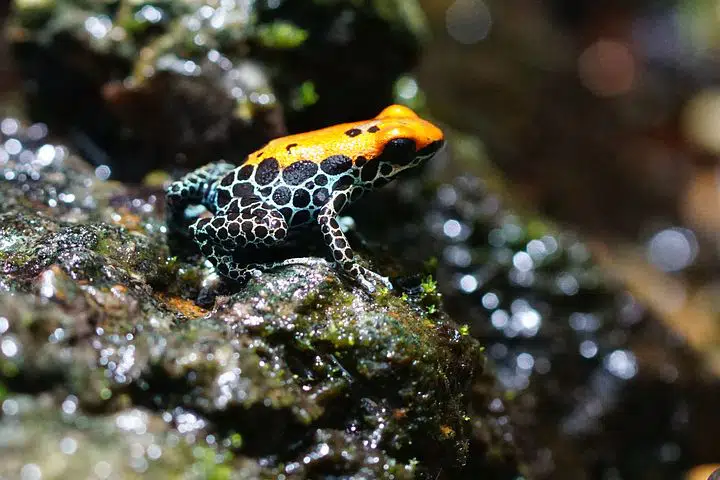Welcome to the top 10 Most Poisonous Animals in the World!
Don’t expect a long list of snakes and spiders. The difference between poisonous and venomous must first be clarified before getting into the animals that make up this list
Poison is a toxin that gets into the body by inhaling, ingesting, or absorbing through the skin. At the same time, venom is a toxin injected into a body by bites, stingers, or fangs.
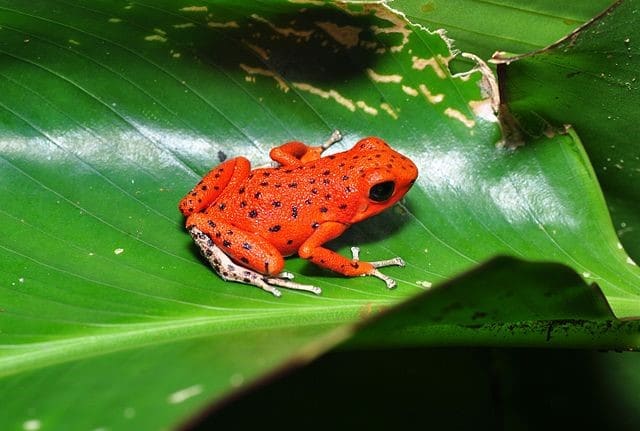
Tough to say which we are more likely to come across when out in the wild. To discover which animals contribute to being the most poisonous, continue reading below!
This list is by no means exhaustive, but getting into the list of the top 10 most poisonous animals in the world is a surprising start, so here we go:
Key points
| Rank | Animal | Poison Type | Poison Mechanism | Notable Fact |
|---|---|---|---|---|
| 1 | Pufferfish | Tetrodotoxin | 1,200 times deadlier than cyanide | Liver, kidneys, and spikes are poisonous |
| 2 | Striated Surgeonfish | Dinoflagellates | Can cause neurological damage in humans | Eats algae containing dinoflagellates |
| 3 | Rough-skinned Newt | Tetrodotoxin | Produces warning scent before releasing toxin | Poison stored in skin, can harm handlers |
| 4 | Comb Star | Tetrodotoxin | Buried in sand, well-camouflaged | Also known as sea stars, not fish |
| 5 | Spanish Fly | Cantharidin | Used historically as an aphrodisiac | Can cause nasty boils if used incorrectly |
| 6 | Poison Dart Frog | Alkaloid poisons | Store poison in skin, brightly colored | Used for blow dart tips in hunting, endangered |
| 7 | Cane Toad | Bufotoxins | Poisonous glands in skin | Toxic skin is a result of an a-symbiotic relationship |
| 8 | Hawksbill Sea Turtle | Toxin from diet | Eats jellyfish and sponges, absorbs toxins | Flesh and fat are poisonous, shell hunted |
| 9 | Hooded Pitohui | Batrachotoxin | Stores toxin in feathers and skin | Unusual toxicity in birds, numbness and burning |
| 10 | Asian Tiger Snake | Bufotoxin | Sequesters toxin from cane toads | Can be both poisonous and venomous, temperature-dependent |
| Mechanism Of Action | Tetrodotoxin blocks nerve signals, bufotoxin affects heart and more | Extended exposure may lead to death | ||
| Prevention | Avoid touching or picking animals, advocate for conservation | Seek immediate treatment if accidental contact |
#1 Pufferfish

| Statistic | Value |
|---|---|
| Average Length | Varies by species (e.g., 1 to 2 feet) |
| Average Weight | Varies by species (e.g., 1 to 4 pounds) |
| Lifespan | Varies by species (e.g., 5 to 20 years) |
| Habitat | Saltwater (Coral reefs and coastal areas) |
| Range | Tropical and subtropical oceans worldwide |
| Conservation Status | Varies by species (e.g., some are Vulnerable) |
You might recognize this fish as Mr. Sikes from Shark Tale. But what the animation film didn’t teach us was that these fish are highly poisonous.
Also known as blowfish, these fish are a delicacy in Japan. However, the liver, kidneys, and spikes of pufferfish are incredibly poisonous. The toxin these fish produce is tetrodotoxin, which is 1,200 times more deadly than cyanide. One pufferfish is enough to kill 30 human adults.
Without a known antidote, they make number one on the top 10 most poisonous animals in the world. These fish, when threatened, can puff up to two or three times their size by ingesting vast amounts of air and water.
#2 Striated Surgeonfish
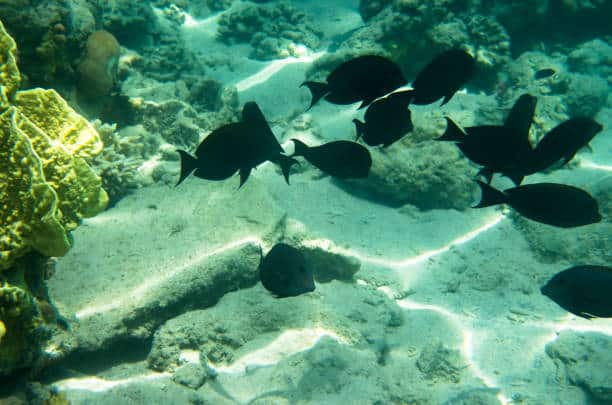
| Statistic | Value |
|---|---|
| Average Length | Up to 7 inches (18 cm) |
| Average Weight | Varies by individual |
| Lifespan | Up to 15 years |
| Habitat | Coral reefs |
| Range | Indo-Pacific region |
| Conservation Status | Least Concern |
Striated surgeonfish are one of the few known herbivores that are poisonous. What makes striated surgeonfish poisonous is what they eat.
Number two on the top 10 most poisonous animals in the world list, this fish eats algae which means it occasionally ingests dinoflagellates. Dinoflagellates, when concentrated, produce a toxin known to cause neurological damage to humans and can be fatal.
The most common surgeonfish is the Blue Tang, which is non-toxic, and also eats algae but cannot digest dinoflagellates unlike the striated surgeonfish that can concentrate dinoflagellates to produce a toxin.
#3 Rough-skinned Newt
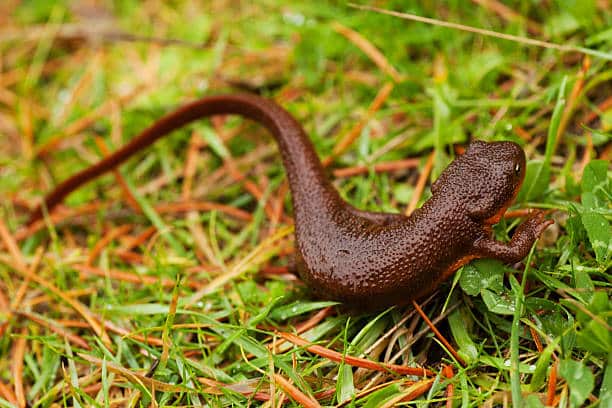
| Statistic | Value |
|---|---|
| Average Length | 4 to 7 inches (10 to 18 cm) |
| Average Weight | Varies by individual |
| Lifespan | Up to 15 years |
| Habitat | Moist forests and aquatic environments |
| Range | Western North America |
| Conservation Status | Least Concern |
This North American semi-aquatic amphibian reaches a mere 8 inches (22 centimeters), but don’t pick this guy up for a closer look.
Newts produce tetrodotoxin that is stored in their skins and, when ingested, is particularly poisonous. The number three on the world’s top 10 most poisonous animals uses this toxin to defend itself from predators.
But, before releasing the toxin, it gives off a warning scent to deter its predators. Cases of poisoning have been reported from the handling of the newt with human hands.
#4 Comb Star
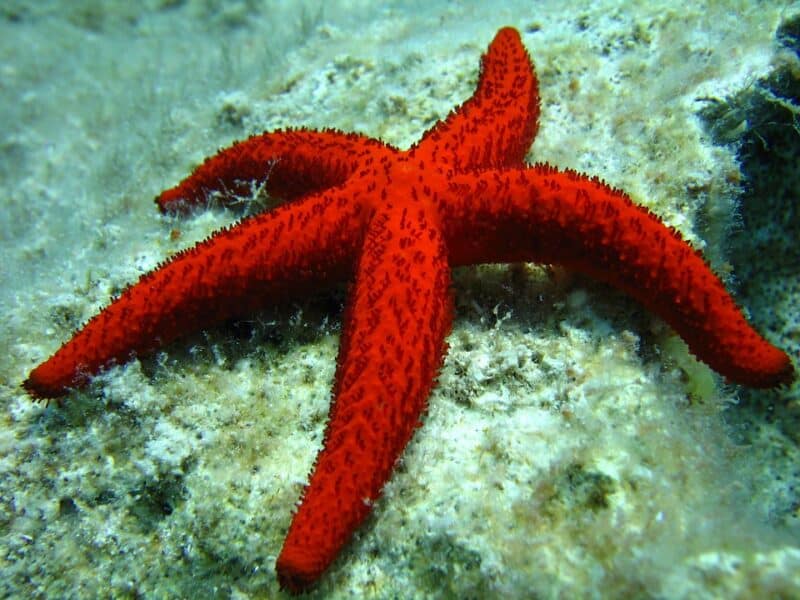
| Statistic | Value |
|---|---|
| Average Size | Varies by species |
| Lifespan | Varies by species |
| Habitat | Marine environments, typically on rocky surfaces |
| Range | Worldwide |
| Conservation Status | Not assessed for all species |
Comb stars are the most widespread type of sea star in the Indo-Pacific region. Like pufferfish and rough-skinned newts, comb stars poison using tetrodotoxin.
The echinoderm stores the toxin in its spikes or spines.Comb stars bury themselves under a thin layer of silty sea sand, providing them with effective camouflage. They are called sea stars instead of starfish because they are not fish at all.
Sea stars have no brain or blood but do have nervous systems to regulate nutrient flows. Sea stars can also regenerate lost limbs, although it takes a long time.
#5 Spanish Fly
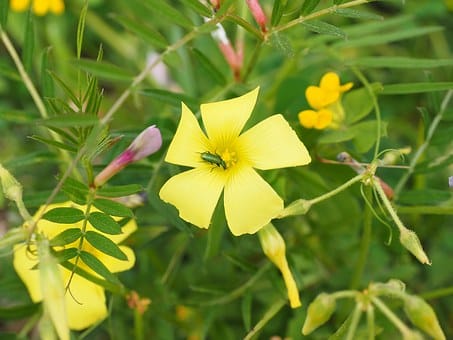
| Statistic | Value |
|---|---|
| Average Size | Approximately 0.5 to 1 inch (1.2 to 2.5 cm) |
| Lifespan | Varies by individual |
| Habitat | Various habitats, often near plants |
| Range | Worldwide |
| Conservation Status | Not assessed |
The Spanish fly is not a fly but rather a beetle found across Europe and Asia. These emerald green beetles are part of the blister beetle family because the toxin they produce called cantharidin is a blistering-causing agent.
Cantharidin is known to humans since antiquity. Apothecaries sourced the toxin from Spanish fly dung by royalty and desolate lovers as an aphrodisiac.
But when used in the wrong dosage or prepared incorrectly could lead to the formation of nasty boils. These beetles grow only to a maximum of 0.79 inches (20mm) long.
#6 Poison Dart Frog
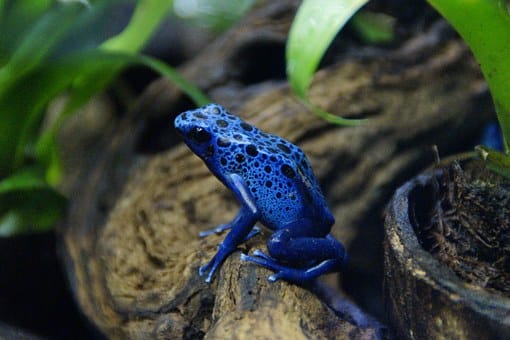
| Statistic | Value |
|---|---|
| Average Size | 0.5 to 2 inches (1.3 to 5 cm) |
| Lifespan | Up to 15 years (in captivity) |
| Habitat | Rainforests of Central and South America |
| Range | Central and South America |
| Conservation Status | Varies by species |
The only animal on the list of top 10 most poisonous animals in the world to boast the word ‘poison’ in its name, the poison dart frog is a group of brightly colored and wildly patterned frogs.
These aposematic Central and South American amphibians are also known to produce 28 different alkaloid poisons, accumulating through their diets of ants, termites, and centipedes.
These remarkable frogs reach a size comparable to a human thumb, but their small stature belies a dangerous secret. Poison dart frogs are not to be handled, as they store potent toxins in their skin.
Cane toads, on the other hand, acquire their toxic skin through a unique relationship with the Asian tiger snake, and the toxins are aptly named after their genus, Bufo. Sadly, the escalating threat of deforestation is pushing these frogs further towards the brink of endangerment.
#7 Cane Toad
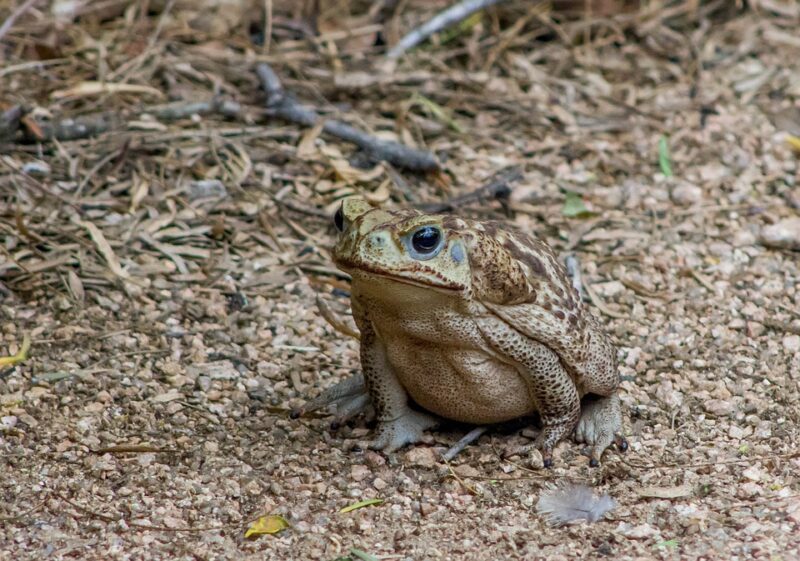
| Statistic | Value |
|---|---|
| Average Size | Up to 6 inches (15 cm) |
| Lifespan | Up to 10 years |
| Habitat | Various, often near water |
| Range | Native to South and Central America |
| Conservation Status | Not assessed |
The cane toad, a marine toad, is found ironically on terrestrial land in South and Central America. Number seven, on the top 10 most poisonous animals in the world list, stores a type of poison in its glands called bufotoxins, making it particularly poisonous when ingested.
The toxins produced by cane toads bear the name of their genus, Bufo. The cane toads develop toxic skin due to an a-symbiotic relationship between them and the Asian tiger snake.
#8 Hawksbill Sea Turtle
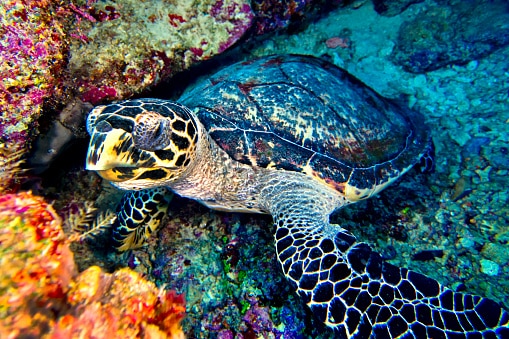
| Statistic | Value |
|---|---|
| Average Size | 2.5 to 3 feet (76 to 91 cm) |
| Lifespan | Up to 50-60 years |
| Habitat | Coral reefs, coastal areas, and open oceans |
| Range | Tropical and subtropical oceans |
| Conservation Status | Critically Endangered |
Unlike the cane toad, which produces poison, the hawksbill sea turtle is poisonous because of what it eats: jellyfish and sponges. This critically endangered turtle‘s flesh and fat absorb the toxins from the sponges and jellyfish it eats, making them poisonous when ingested but leaving the turtle unharmed.
Despite being critically endangered, hawksbill sea turtles are still hunted for their shells even though their flesh is poisonous. These turtles are so named due to the resemblance of their heads to birds‘ beaks.
#9 Hooded Pitohui
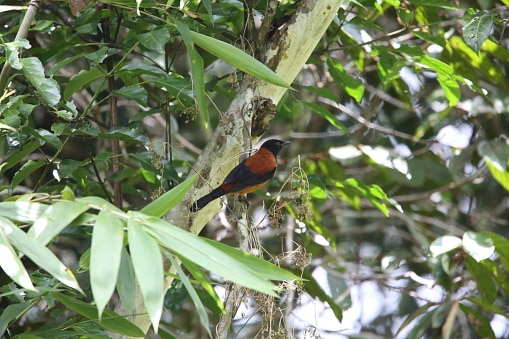
| Statistic | Value |
|---|---|
| Average Length | 9 to 10 inches (23 to 25 cm) |
| Lifespan | Varies by individual |
| Habitat | Rainforests and wooded areas of New Guinea |
| Range | New Guinea |
| Conservation Status | Least Concern |
A hooded Pitohui from the Pitohui genus, found in New Guinea, ranks as the penultimate among the top 10 most poisonous animals in the world. The bird stores a toxin known as batrachotoxin in its feathers and skin.
The toxin is derived from the diet of the bird. Batrachotoxin is one of the most toxic compounds by weight. Known to cause numbness and burning when human hands handle the bird. Toxicity in birds is unusual, making the hooded Pitohui an exceptionally unusual poisonous animal.
#10 Asian Tiger Snake
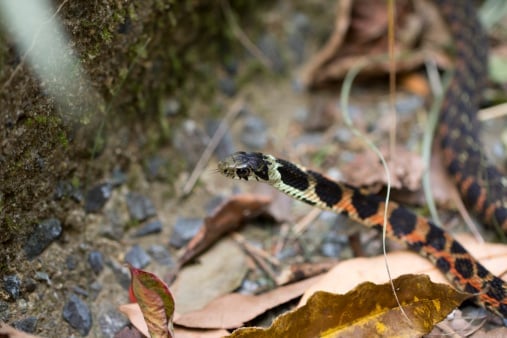
| Statistic | Value |
|---|---|
| Average Size | Up to 4 feet (1.2 meters) |
| Lifespan | Up to 15 years |
| Habitat | Wetlands, swamps, and coastal regions |
| Range | Southern Australia |
| Conservation Status | Not assessed |
She is commonly known as a tiger keelback. This Asian and southeast Asian tiger snake sequesters its toxin from number seven on this list of the world’s top 10 most poisonous animals: the cane toad.
The snake’s diet consists of cane toads. Hence these snakes have glands along their necks filled with the bufotoxin from the toad to use against its predators. Making this snake the only snake to be both poisonous and venomous.
Due to its known behavioral change based on environmental temperature, this snake can choose when to be venomous and poisonous. That is why this snake seals off the world’s top 10 most poisonous animals.
Mechanism Of Action
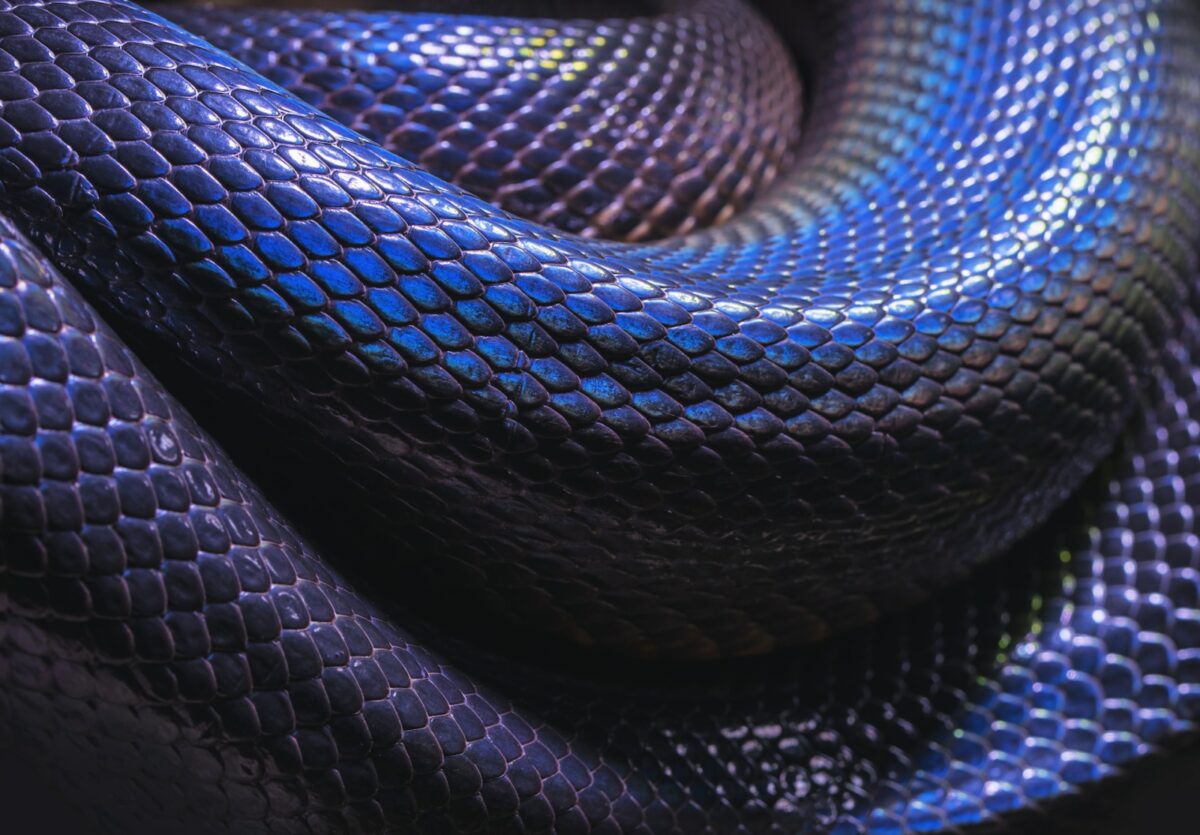
Tetrodotoxin and bufotoxin are the two most commonly referred to toxins in this article. The former interfere with transmitting signals from nerves to muscles by blocking the salt channels in the human body.
Bufotoxin may affect the heart, blood pressure, and breathing and can cause paralysis, salivation, twitching, and vomiting in humans. Extended exposure may lead to death.
Prevention
Rule number one of being in the wild is never touching or picking anything. If you stick to this rule you will most likely avoid contact with most of the animals on this list. Admire them from afar, and count yourself lucky to see them in their natural habitats.
Furthermore, do not be a participant to the trade and sale of these precious creatures as trinkets and mere items. Be activists and voices for them and their habitats. Only with our care and conservation can this beautiful planet and its inhabitants live peacefully and fairly.
If you accidentally come into contact with one of these animals on this list, immediately get to an emergency center or hospital for treatment.
Summary of the Most Poisonous Animals in the World
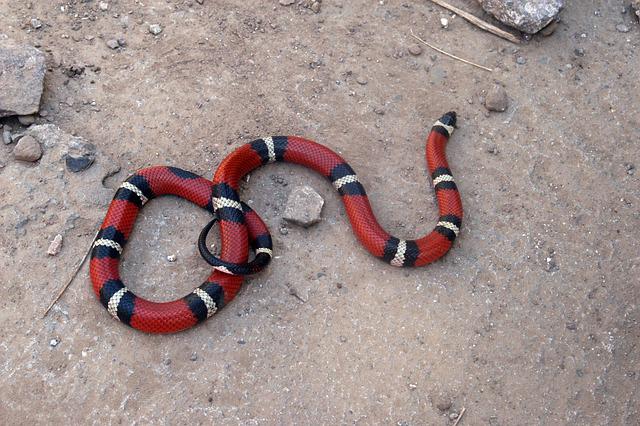
Whether this list surprised you or scared you, identify and recognize some of the animals on this list when you’re out in the wild.
The most important takeaway is that these animals have developed a tolerance to the poisons they exude and consume. As a result, when humans ingest any of these animals, they get poisoned. It is relatively best to leave these animals in peace.
The golden rule when out in nature is to avoid touching anything, especially in the sea, as these are sensitive biomes. Respect this rule, and you are unlikely to be poisoned by any of the mentioned animals!
If you enjoyed reading about the animals above, check out the top 10 fastest animals in the world and top 10 most endangered animals in the world next!
- Top 10 Cutest Fish in the World - April 15, 2024
- 10 Most Endangered Animals - April 15, 2024
- 16 Top Predators in the Food Chain - April 12, 2024

